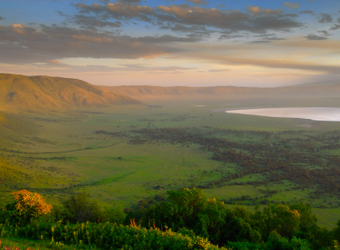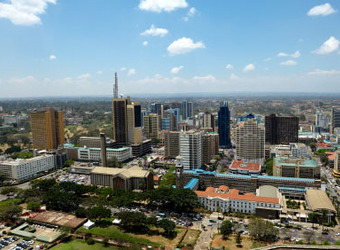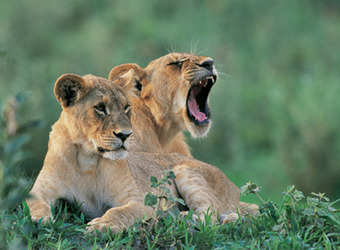Epic Tanzania, Kenya & Rwanda Safari (Dec-Jun)
19 days, 18 nights
Price Range:
$21,153 – $54,887
(all-inclusive price per person, depending on dates & camps selected)
 view larger image
view larger image
From the great plains of the Serengeti and Maasai Mara to the swamps of Amboseli in the shadow of Kilimanjaro, from the wildlife Eden of Ngorongoro Crater to the rainforests of Rwanda that shelter endangered mountain gorilla, this grand safari truly has it all. Though timing is never certain, this route is designed to dovetail with the wildebeest migration, when well over a million animals move across the Serengeti.

Our Expert Says
I can’t imagine a better way to spend three weeks in East Africa! Beginning with the Serengeti and the Ngorongoro Crater in Tanzania, continuing to the wildlife highlights of Kenya including a private conservancy and world-renowned parks, and culminating with two days to track mountain gorillas in Rwanda--this is the East African safari of your dreams!
– Sarah Raby
 view image gallery
view image gallery
Day 1: Arusha
Arusha is the safari capital of the world, the jumping-off point for the Serengeti, Ngorongoro Crater and Kilimanjaro. In the shadow of Mount Meru, where lush forest intersects grassy savanna, Arusha sits within an agricultural region famed for coffee and tea. Originally a German settlement, Arusha today is a lively city with an international flair. Arusha is noted for handcrafts, and the Cultural Heritage Center boasts an array of carvings, paintings, batiks and baskets.
 view image gallery
view image gallery
Days 2-4: Serengeti Nat'l Park
The Serengeti is legendary. Here on Africa’s Great Plains, where the blue sky arcs over shimmering gold grasslands, the number of animals is staggering. Buffalo, elephant and giraffe roam the savanna. Leopards rest in acacia trees, pursuing prey with lion, cheetah, jackal and hyena. While the Serengeti is riveting year-round, nothing matches the phenomenon of the migration, when 1.5 million wildebeest and zebra traverse the plains in endless columns of thundering hoofbeats.
 view image gallery
view image gallery
Days 5-6: Ngorongoro Crater
Within the walls of the world’s largest unbroken volcanic caldera is the densest concentration of wildlife in Africa. The crater floor, 12 miles across, is a wonder of the natural world. More than 30,000 animals live in this primeval Eden, including huge herds of gazelle and the lion and hyena that prey upon them. Wildebeest, zebra, eland and giraffe are abundant, with leopard and cheetah in pursuit. The very fortunate may also spot the endangered black rhino.
 view image gallery
view image gallery
Day 7: Nairobi
A rough outpost amidst a highland swamp as the colonial capital of British East Africa in 1907, Nairobi today is the urban heartbeat of independent Kenya and one of Africa’s most important cities. Nairobi has long been a meeting point for adventurers and travelers from all over the world, and most Kenya safaris still originate here. Nairobi’s national museum and the historic home of Karen Blixen, author of Out of Africa, are popular attractions.
 view image gallery
view image gallery
Days 8-9: Amboseli / Chuylu Hills
Elephants abound in Amboseli, and to see these African icons against the backdrop of snow-topped Mount Kilimanjaro is a timeless image of the continent. This mosaic of dusty plains and swampy springs is also home to buffalo, wildebeest, zebra, impala, hyena, lion, leopard, cheetah and a third of Kenya’s nearly 1,100 bird species. The nearby photogenic black lava Chyulu Hills are a captivating area of ancient craters, rolling grasslands and aromatic cedar forest.
 view image gallery
view image gallery
Days 10-11: Lewa / Laikipia
The dramatic Laikipia region, wild and sparsely populated, has become a center for global conservation leadership. Much of Laikipia is comprised of privately owned ranches that have been combined by local communities to create vast conservancies, with free-ranging wildlife including elephant, lion, leopard, buffalo and abundant plains game. Renowned among Laikipia’s sanctuaries is Lewa Wildlife Conservancy, which has played a critical role in sustaining endangered rhinoceros, Grevy’s zebra and sitatunga.
 view image gallery
view image gallery
Days 12-14: Maasai Mara Nat'l Reserve
The famed Maasai Mara is one of Africa’s most acclaimed wildlife reserves, renowned for its wildebeest migration, prides of lion and huge herds of plains animals. The Mara is the northern portion of the Serengeti Plains, and we find excellent wildlife viewing all year long in these grasslands. The reserve is named for the Maasai tribespeople, the traditional inhabitants of the area who graze cattle here, and the Mara River that runs through it.
 view image gallery
view image gallery
Day 15: Nairobi
Return to Nairobi to spend the night before continuing in the morning into Rwanda and Volcanoes National Park.
 view image gallery
view image gallery
Days 16-18: Volcanoes Nat'l Park
Track gorillas in the early morning on the forested slopes of the ancient Virunga volcano chain in Africa’s oldest national park. Established in 1925 to protect the mountain gorilla, the park was the base for famous American naturalist Dian Fossey’s research. On the western edge of Rwanda bordering parks in both Uganda and the Democratic Republic of the Congo, the combined region is home to approximately 604 mountain gorillas, just over half the world’s total.
 view image gallery
view image gallery
Day 19: Kigali/Home
Your safari adventure ends today in Kigali, Rwanda.
